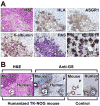The reconstituted 'humanized liver' in TK-NOG mice is mature and functional
- PMID: 21238430
- PMCID: PMC3648850
- DOI: 10.1016/j.bbrc.2011.01.042
The reconstituted 'humanized liver' in TK-NOG mice is mature and functional
Abstract
To overcome the limitations of existing models, we developed a novel experimental in vivo platform for replacing mouse liver with functioning human liver tissue. To do this, a herpes simplex virus type 1 thymidine kinase (HSVtk) transgene was expressed within the liver of highly immunodeficient NOG mice (TK-NOG). Mouse liver cells expressing this transgene were ablated after a brief exposure to a non-toxic dose of ganciclovir (GCV), and transplanted human liver cells are stably maintained within the liver (humanized TK-NOG) without exogenous drug. The reconstituted liver was shown to be a mature and functioning "human organ" that had zonal position-specific enzyme expression and a global gene expression pattern representative of mature human liver; and could generate a human-specific profile of drug metabolism. The 'humanized liver' could be stably maintained in these mice with a high level of synthetic function for a prolonged period (8 months). This novel in vivo system provides an optimized platform for studying human liver physiology, including drug metabolism, toxicology, or liver regeneration.
Copyright © 2011 Elsevier Inc. All rights reserved.
Figures



References
-
- Suemizu H, Hasegawa M, Kawai K, Taniguchi K, Monnai M, Wakui M, Suematsu M, Ito M, Peltz G, Nakamura M. Establishment of a humanized model of liver using NOD/Shi-scid IL2Rg(null) mice. Biochem Biophys Res Commun. 2008;377:248–252. - PubMed
-
- Dandri M, Burda MR, Torok E, Pollok JM, Iwanska A, Sommer G, Rogiers X, Rogler CE, Gupta S, Will H, Greten H, Petersen J. Repopulation of mouse liver with human hepatocytes and in vivo infection with hepatitis B virus. Hepatology. 2001;33:981–988. - PubMed
-
- Mercer DF, Schiller DE, Elliott JF, Douglas DN, Hao C, Rinfret A, Addison WR, Fischer KP, Churchill TA, Lakey JR, Tyrrell DL, Kneteman NM. Hepatitis C virus replication in mice with chimeric human livers. Nat Med. 2001;7:927–933. - PubMed
Publication types
MeSH terms
Substances
Grants and funding
LinkOut - more resources
Full Text Sources
Other Literature Sources
Molecular Biology Databases

